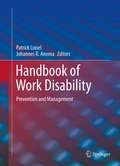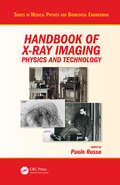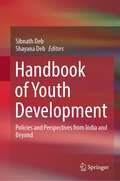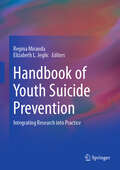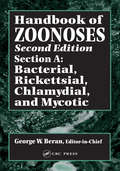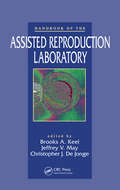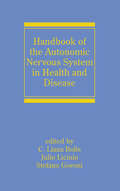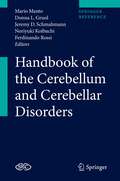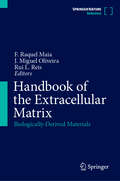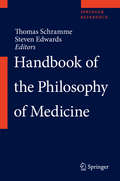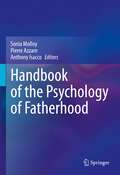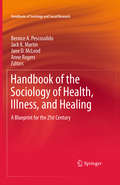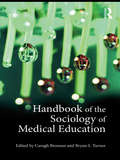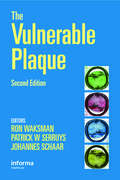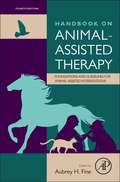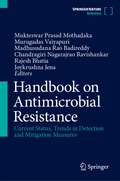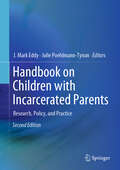- Table View
- List View
Handbook of Women's Health
by Jo Ann RosenfeldThis practical handbook provides a clear and comprehensive evidence-based guide to the care of women in primary care, intended for general and family practitioners, nurses, physician assistants, and all those who practise primary care of women. It emphasizes preventive and well-woman care throughout the life-cycle of a woman, including sexuality, contraception, medical care in pregnancy, and psychological and important medical concerns. This new edition, revised and updated throughout with several new contributing authors, incorporates the latest evidence and research-findings on a wide range of problems for which women seek medical guidance. There is an expanded section on menstrual problems and menopause-associated conditions, including clear guidance on the use of hormone replacement therapy.
Handbook of Work Disability
by Johannes R. Anema Patrick LoiselThis book addresses the developing field of Work Disability Prevention. Work disability does not only involve occupational disorders originating from the work or at the workplace, but addresses work absenteeism originating from any disorder or accident. This topic has become of primary importance due to the huge compensation costs and health issues involved. For employers it is a unique burden and in many countries compensation is not even linked to the cause of the disorder. In the past twenty years, studies have accumulated which emphasize the social causes of work disability. Governments and NGOs such as the World Bank, the International Labor Organization, and the Organization for Economic Cooperation and Development have produced alarming reports on the extent of this problem for developed and developing countries. However, no comprehensive book is presently available to help them address this emerging field where new knowledge should induce new ways of management.
Handbook of X-ray Imaging: Physics and Technology (Series in Medical Physics and Biomedical Engineering)
by Paolo RussoContaining chapter contributions from over 130 experts, this unique publication is the first handbook dedicated to the physics and technology of X-ray imaging, offering extensive coverage of the field. This highly comprehensive work is edited by one of the world’s leading experts in X-ray imaging physics and technology and has been created with guidance from a Scientific Board containing respected and renowned scientists from around the world. The book's scope includes 2D and 3D X-ray imaging techniques from soft-X-ray to megavoltage energies, including computed tomography, fluoroscopy, dental imaging and small animal imaging, with several chapters dedicated to breast imaging techniques. 2D and 3D industrial imaging is incorporated, including imaging of artworks. Specific attention is dedicated to techniques of phase contrast X-ray imaging. The approach undertaken is one that illustrates the theory as well as the techniques and the devices routinely used in the various fields. Computational aspects are fully covered, including 3D reconstruction algorithms, hard/software phantoms, and computer-aided diagnosis. Theories of image quality are fully illustrated. Historical, radioprotection, radiation dosimetry, quality assurance and educational aspects are also covered. This handbook will be suitable for a very broad audience, including graduate students in medical physics and biomedical engineering; medical physics residents; radiographers; physicists and engineers in the field of imaging and non-destructive industrial testing using X-rays; and scientists interested in understanding and using X-ray imaging techniques. The handbook's editor, Dr. Paolo Russo, has over 30 years’ experience in the academic teaching of medical physics and X-ray imaging research. He has authored several book chapters in the field of X-ray imaging, is Editor-in-Chief of an international scientific journal in medical physics, and has responsibilities in the publication committees of international scientific organizations in medical physics. Features: Comprehensive coverage of the use of X-rays both in medical radiology and industrial testing The first handbook published to be dedicated to the physics and technology of X-rays Handbook edited by world authority, with contributions from experts in each field
Handbook of Youth Development: Policies and Perspectives from India and Beyond
by Sibnath Deb Shayana DebThis handbook provides a comprehensive overview of youth development, including theories and applications across different countries, namely India, the UK, and Australia. It presents the status of youth and their role in society, their education, and their career perspectives. The focus is on developing youth's internal abilities by providing a creative and supportive environment through appropriate mentorship and encouragement. It discusses a wide range of contemporary and relevant issues relating to holistic career growth of youth, whereby youth work is recognized as a profession. Academicians from various disciplinary backgrounds offer conceptual and methodological perspectives. Chapters into five themes focus on a balance between developing stable, protective factors for mental health, and positive youth development to ensure appropriate cognitive, social, emotional, and behavioral skills needed to thrive in an evolving world. It discusses the status of the youth in terms of digital competency, engagement of youth in sports, teaching, political process, and community development activities in the present and rapidly altering world scenario. The book also discusses the role of institution-based family counseling for healthy youth development. Given its comprehensive coverage, the handbook is an essential resource for a broad audience of youth researchers, practitioners and policymakers of population sciences, childhood and youth studies, development studies, and psychology.
Handbook of Youth Suicide Prevention: Integrating Research into Practice
by Regina Miranda Elizabeth L. JeglicThis handbook examines research on youth suicide, analyzes recent data on suicide among adolescents, and addresses the subject matter as a serious public health concern. The book explores the research on youth suicide, examining its causes, new and innovative ways of determining suicide risk, and evidence-based intervention and prevention strategies. In addition, it focuses on specific under-studied populations, including adolescents belonging to ethnic, racial, and sexual minority groups, youth involved in the criminal justice system, and adolescents in foster care. The book discusses how culturally informed and targeted interventions can help to decrease suicide risk for these populations.Key areas of coverage include:Early childhood adversity, stress, and developmental pathways of suicide risk.The neurobiology of youth suicide.Suicide, self-harm, and the media.Assessment of youth suicidal behavior with explicit and implicit measures.Suicide-related risk among immigrant, ethnic, and racial minority youth.LGBTQ youth and suicide prevention.Psychosocial treatments for ethnoculturally diverse youth with suicidal thoughts and behaviors.Technology-enhanced interventions and youth suicide prevention. The Handbook of Youth Suicide Prevention is an essential resource for researchers, professors, graduate students as well as clinicians, therapists, and other professionals in developmental psychology, social work, public health, pediatrics, family studies, child and adolescent psychiatry, school and educational psychology, and all interrelated disciplines.
Handbook of Zoonoses, Second Edition, Section A: Bacterial, Rickettsial, Chlamydial, and Mycotic Zoonoses
by George W. BeranThis multivolume handbook presents the most authoritative and comprehensive reference work on major zoonoses of the world. The Handbook of Zoonoses covers most diseases communicable to humans, as well as those diseases common to both animals and humans. It identifies animal diseases that are host specific and reviews the effects of various human diseases on animals. Discussions address diseases that remain important public and animal health problems and the techniques that can control and prevent them.The chapters are written by internationally recognized scientists in their respective areas of disease, who work or have worked extensively in the most affected areas of the world. The emphasis for each zoonosis is on the epidemiology of the disease, the clinical syndromes and carrier states in infected animals and humans, and the most current methods for diagnosis and approaches to control. For infectious agents or biologic toxins, which may be transmitted by foods of animal origin, a strong focus is placed on food safety measures. The etiologic and therapeutic aspects of each disease important to epidemiology and control are identified.
Handbook of Zoonoses, Section B: Viral Zoonoses
by George W. Beran and James H. SteeleThis multivolume handbook presents the most authoritative and comprehensive reference work on major zoonoses of the world. The Handbook of Zoonoses covers most diseases communicable to humans, as well as those diseases common to both animals and humans. It identifies animal diseases that are host specific and reviews the effects of various human diseases on animals. Discussions address diseases that remain important public and animal health problems and the techniques that can control and prevent them.The chapters are written by internationally recognized scientists in their respective areas of disease, who work or have worked extensively in the most affected areas of the world. The emphasis for each zoonosis is on the epidemiology of the disease, the clinical syndromes and carrier states in infected animals and humans, and the most current methods for diagnosis and approaches to control. For infectious agents or biologic toxins, which may be transmitted by foods of animal origin, a strong focus is placed on food safety measures. The etiologic and therapeutic aspects of each disease important to epidemiology and control are identified.
Handbook of the Assisted Reproduction Laboratory
by Paul C. H. LiWith the advent of Assisted Reproductive Technologies, our understanding of the reproductive system in both men and women has progressed in an exponential manner.Along with this increase in knowledge has emerged new and advanced laboratories performing unique techniques aimed at diagnosing and treating infertility problems. And as these lab
Handbook of the Autonomic Nervous System in Health and Disease
by Liana Bolis Julio Licinio Stefano GovoniExamines the role of the ANS in the maintenance and control of bodily homeostasis, as well as in the pathogenesis, pathophysiology, and treatment of disorders such as cardiovascular disease, hypertension, asthma, arrhythmia, diabetes, ischemia, myocardial infarction, urinary retention, and depression.
Handbook of the Cerebellum and Cerebellar Disorders
by Mario Manto Donna Gruol Ferdinando Rossi Jeremy Schmahmann Noriyuki KoibuchiOur knowledge of cerebellar functions and cerebellar disorders, called ataxias, is increasing considerably. Studies of the cerebellum are now a central focus in neuroscience. During the last four decades, many laboratories worldwide have dedicated their research activities to understanding the roles of the cerebellum in motor control, cognitive processes and biology of mental processes, behavioral symptoms, and emotion. It is now accepted that the cerebellum acts as a cognitive operator in learning, perception, and attention. Moreover, major improvements in our assessment of in vivo cerebellar architecture using imaging techniques have occurred. A typical example is the accurate description of cerebellar anatomy during fetal development with MRI, a progress which has direct impacts on patient care. These advances have been associated with discoveries of new clinical disorders, in particular in the field of genetic ataxias. More than 20 new genes have been identified these last 10 years. Only for dominant ataxias, more than 30 diseases have now been unravelled. The number of ataxic disorders will increase with aging, the cerebellum being the structure of the brain with the most important loss of neurons with age. More than 300 different cerebellar disorders are encountered during daily practice, but we are missing a single source of information explaining their pathogenesis. Despite the immense amount of knowledge acquired about the cerebellar circuitry these last years, a large book covering the neuroscience of the cerebellum is missing. The goal of this endeavour is to bring up to date information relevant for basic science and also for clinical activities. To reach this goal, the most renowned authors are gathered in a unique and in-depth book with a format of a handbook. We emphasize the connections between molecular findings, imaging features, behavioural/neuropsychological aspects, and clinical implications.
Handbook of the Cerebellum and Cerebellar Disorders
by Noriyuki Koibuchi Donna L. Gruol Jeremy D. Schmahmann Roy V. Sillitoe Mario U. MantoOur knowledge of cerebellar functions and cerebellar disorders, called ataxias, is increasing considerably. Studies of the cerebellum are now a central focus in neuroscience. During the last four decades, many laboratories worldwide have dedicated their research activities to understanding the roles of the cerebellum in motor control, cognitive processes and biology of mental processes, behavioral symptoms, and emotion. It is now accepted that the cerebellum acts as a cognitive operator in learning, perception, and attention. Moreover, major improvements in our assessment of in vivo cerebellar architecture using imaging techniques have occurred. A typical example is the accurate description of cerebellar anatomy during fetal development with MRI, a progress which has direct impacts on patient care. These advances have been associated with discoveries of new clinical disorders, in particular in the field of genetic ataxias. More than 20 new genes have been identified these last 10 years. Only for dominant ataxias, more than 30 diseases have now been unravelled. The number of ataxic disorders will increase with aging, the cerebellum being the structure of the brain with the most important loss of neurons with age. More than 300 different cerebellar disorders are encountered during daily practice, but we are missing a single source of information explaining their pathogenesis. Despite the immense amount of knowledge acquired about the cerebellar circuitry these last years, a large book covering the neuroscience of the cerebellum is missing. The goal of this endeavour is to bring up to date information relevant for basic science and also for clinical activities. To reach this goal, the most renowned authors are gathered in a unique and in-depth book with a format of a handbook. We emphasize the connections between molecular findings, imaging features, behavioural/neuropsychological aspects, and clinical implications.
Handbook of the Clinical Treatment of Infidelity
by Joseph L. Wetchler Fred P Piercy Katherine Milewski HertleinHelp your clients&’ relationships survive infidelity!In the Handbook of the Clinical Treatment of Infidelity, a panel of seasoned experts reflects on issues central to affairs, and on how to help couples heal and learn from them. First, editors Fred P. Piercy, Katherine M. Hertlein, and Joseph L. Wetchler provide an essential overview of infidelity theory, research, and treatment. They discuss the effect of infidelity on couples and delineate three types of infidelity-emotional, physical, and infidelity including aspects of both. They review the relatively new role of the Internet in infidelity and explore infidelity within the context of comarital relationships. Finally, they discuss the overarching theories and common models used in infidelity treatment.Also in the Handbook of the Clinical Treatment of Infidelity: Susan M. Johnson, the co-developer of Emotionally Focused Therapy (EFT), discusses affairs through the lens of attachment theory, and shows how EFT provides a way to acknowledge and express pain, remorse, and regret, and to repair this attachment bond. David Moultrup takes a Bowenian approach to infidelity, focusing attention on the underlying dynamics of the emotional system Frank Pittman and Tina Pittman Wagers outline cultural myths about affairs and do their share of debunking Adrian Blow discusses how to help couples directly address their pain-and the challenges of the healing process Brian Case highlights the role of apology and forgiveness in the healing process Frank Stalfa and Catherine Hastings focus on the treatment of "accusatory suffering"-a spouse&’s obsessive holding onto and retaliating for an affair long after it has ended, and despite the offending partner&’s repeated apologies and attempts at restitution Don-David Lusterman discusses individuals who have suppressed or denied traumatic stress reactions to their partner&’s affair, and how to help them Scott Johnson discusses myths about affairs, from who is cheating on whom, to whether men really have more affairs than women, to the blame-filled language of "affairs," "betrayal," and "infidelity," asking us to think more systematically about affairs and to see the dynamics of extra dyadic relationships as more complex and nuanced than they are typically portrayed in the literature Joan Atwood provides an overview of Internet infidelity-the factors influencing one&’s involvement in this type of infidelity, and some considerations for therapists Tim Nelson, Fred Piercy, and Doug Sprenkle report on the results of a multi-phase Delphi study that explored what infidelity experts say are the critical issues, interventions, and gender differences in the treatment of Internet infidelity Monica Whitty and Adrian Carr draw upon Klein&’s object relations theory and discuss how this might influence the way people rationalize their Internet infidelity Emily Brown outlines the concept of the Split Self Affair-discussing its origins, characteristics, and implications for individuals and couples, and providing detailed information on how to work with these couples in therapy Michael Bettinger presents extra dyadic relationship as a fact, rather than a problem, within many gay male relationships-a discussion that shows how gay male polyamory can work as an alternative to the heterosexual model of emotional and sexual exclusivity in romantic dyadic relationships Katherine Hertlein and Gary Skaggs report on the results of a study that assessed the level of differentiation and one&’s engagement in extra dyadic relationshipsThe Handbook of the Clinical Treatment of Infidelity is essential reading for today&’s (and tomorrow&’s) clinicians who work with couples. Make it a p
Handbook of the Extracellular Matrix: Biologically-Derived Materials
by Rui L. Reis J. Miguel Oliveira F. Raquel MaiaThis book comprises 6 sections covering the fundamentals of the extracellular matrix, as well as the development and challenges of using biologically-derived materials, and its advanced biomedical applications. The first section is dedicated to the extracellular matrix, while the other 5 sections are each dedicated to a particular type of material. This book reports the fundamentals of the extracellular matrix and its impact on the development of innovative materials; provides an overview of the advanced methodologies used to develop biologically-derived materials; and describes the challenges of the synthesis and processing of the different materials. Furthermore, it presents the biological activities, structural and physicochemical properties of such materials, and the modification methods pursued to improve their inherent properties. The wide range of advanced applications are covered as well, including the combination with emerging technologies, underlying tissue-engineered scaffolding, drug delivery systems, 3D in vitro tissue and cancer models, 3D bioprinted models, bioinks, and more. This reference work serves as a core reference for multidisciplinary students (undergraduates and Ph.D. students) and a wide range of established researchers and professionals working in the medical field, e.g., orthopaedics, radiology, dentistry, and cancer.
Handbook of the Medical Consequences of Alcohol and Drug Abuse
by John BrickThe essential newly-expanded reference that needs to be on the desk of every health care professional who encounters substance abusers.Handbook of the Medical Consequences of Alcohol and Drug Abuse, Second Edition is the newly-updated classic reference text that provides even more detailed and expanded information on the pharmacological, toxicological, and neuropsychological consequences of alcohol and drug abuse. Eight new chapters of crucial information have been added. Written by leading experts in the fields of medical physiology, psychopharmacology, and neuropsychology, this valuable resource provides the detailed alcohol and drug information health professionals in all fields need to know. Handbook of the Medical Consequences of Alcohol and Drug Abuse, Second Edition greatly expands on the expert information provided in the first edition. This text provides reviews of the cardiovascular, neurological, pulmonary, gastrointestinal, psychological, and hepatic effects of commonly abused drugs. The book also provides in-depth explanations of the mechanisms by which these psychoactive drugs exert their biobehavioral effects as well as current thinking about—and definitions of—abuse, dependence, and alcohol/drug use. The Handbook of the Medical Consequences of Alcohol and Drug Abuse, Second Edition includes vital information on: alcohol, including definitions of alcohol use, abuse, and dependence the relationship between alcohol and accidental injuries, alcohol’s effect on skeletal and major organ systems, and its effect on risk factors for certain cancers effects of alcohol and other drugs on neuropsychological function the effects of alcohol on neuron signaling, neurotransmitter function, and alcoholic brain damage and cognitive dysfunction fetal alcohol effects chronic effects of marijuana use on psychological and physical health, including a fair and balanced discussion of the medical marijuana issue the consequences of opiate abuse and methadone pharmacotherapy, including a comparison of the effects of methadone and heroin on organ systems cocaine’s history, the various forms of the drug, and the adverse effects of cocaine on cardiovascular, neurologic, and pulmonary systems the medical consequences of inhalants ranging from benzene to xylene the prenatal effects of nicotine, cocaine, marijuana, and opiates terminology that appears in the current literature on alcohol New topics in the Handbook of the Medical Consequences of Alcohol and Drug Abuse, Second Edition include chapters discussing: chemical dependency in psychiatric patients medical consequences of steroids OTC medications hallucinogens health effects of tobacco, nicotine, and exposure to tobacco smoke interactions of alcohol with other drugs and other medications periodontal effects of alcohol and drug abuse in the oral cavity imaging studies of structural brain changes The Handbook of the Medical Consequences of Alcohol and Drug Abuse, Second Edition is an invaluable resource for physicians, scientists, nurses, psychologists, and alcohol and drug counselors.
Handbook of the Philosophy of Medicine
by Thomas Schramme Steven EdwardsPhilosophy of medicine is thought of today as a distinct discipline with its own set of concerns. This title focuses on all major aspects of the philosophy of medicine and the attempts of philosophers, bioethicists, and physicians to address its unique set of problems and questions. It deals with the various metaphysical, ethical and practical problems and questions facing modern medicine such as human nature and mind; reductionism and holism; causation and etiology; notions of disease, health, illness and disability; ageing, death and suicide; medical theory and models; social determinants of health and the role of factors such as technology and evidence-based medicine in providing valid diagnostic and therapeutic knowledge.
Handbook of the Psychology of Fatherhood
by Anthony Isacco Sonia Molloy Pierre AzzamThis handbook examines the psychology of fatherhood throughout the lifespan and across multiple contexts. It synthesizes the trajectory of research and theorization of fathering that has traditionally dominated fatherhood literature. The book explores fathering within the developmental stages of children, from infancy to adulthood. In addition, it addresses the health and well-being of fathers from the perinatal period onward, with a focus on isolation, loss, trauma, and mental and physical health. The book emphasizes positive fatherhood and masculinity, thereby offering new perspectives of fatherhood. It synthesizes cutting-edge research on the intersectionality of fathering and provides knowledge of fatherhood for diverse populations, including military, LGBTQ, and fathers on the margins. The handbook reviews clinical assessment as well as community-based prevention and intervention strategies for issues of fatherhood and examines directions for future public policy and on-the-ground work. It offers recommendations for promoting the health and well-being of fathers and their families from multiple perspectives. Key areas of coverage include:Historical, multicultural, and future directions in the research of fatherhood.Fatherhood and child development, from infancy to emerging adulthood.Grandfathering and adult children.Fatherhood and men’s mental and physical health and well-being.Positive masculinity and fatherhood. The Handbook of the Psychology of Fatherhood is an invaluable resource for researchers, clinicians and practitioners, and policy advocates as well as graduate students in developmental psychology, social work, public health, pediatrics, human development, family studies, child and adolescent psychiatry, school and educational psychology, and all interrelated disciplines.
Handbook of the Sociology of Health, Illness, and Healing
by Bernice A. Pescosolido Anne Rogers Jack K. Martin Jane D. McleodThe Handbook of the Sociology of Health, Illness & Healing advances the understanding of medical sociology by identifying the most important contemporary challenges to the field and suggesting directions for future inquiry. The editors provide a blueprint for guiding research and teaching agendas for the first quarter of the 21st century. In a series of essays, this volume offers a systematic view of the critical questions that face our understanding of the role of social forces in health, illness and healing. It also provides an overall theoretical framework and asks medical sociologists to consider the implications of taking on new directions and approaches. Such issues may include the importance of multiple levels of influences, the utility of dynamic, life course approaches, the role of culture, the impact of social networks, the importance of fundamental causes approaches, and the influences of state structures and policy making.
Handbook of the Sociology of Medical Education
by Bryan S. Turner Caragh BrosnanThe Handbook of the Sociology of Medical Education provides a contemporary introduction to this classic area of sociology by examining the social origin and implications of the epistemological, organizational and demographic challenges facing medical education in the twenty-first century. Beginning with reflections on the historical and theoretical foundations of the sociology of medical education, the collection then focuses on current issues affecting medical students, the profession and the faculty, before exploring medical education in different national contexts. Leading sociologists analyze: the intersection of medical education and social structures such as gender, ethnicity and disability; the effect of changes in medical practice, such as the emergence of evidence-based medicine, on medical education; and the ongoing debates surrounding the form and content of medical curricula. By examining applied problems within a framework which draws from social theorists such as Pierre Bourdieu, this new collection suggests future directions for the sociological study of medical education and for medical education itself.
Handbook of the Sociology of Mental Health
by Carol S. Aneshensel Alex Bierman Jo C. PhelanThis second edition of the Handbook of the Sociology of Mental Health features theory-driven reviews of recent research with a comprehensive approach to the investigation of the ways in which society shapes the mental health of its members and the lives of those who have been diagnosed as having a mental illness The award-winning Handbook is distinctive in its focus on how the organization and functioning of society influences the occurrence of mental disorder and its consequences. A core issue that runs throughout the text concerns the differential distribution of mental illness across various social strata, defined by status characteristics such as gender, race/ethnicity, socioeconomic status, and age. The contributions to this volume shed light on the social, cultural, and economic factors that explain why some social groups have an elevated risk of disorder. They also address the social repercussions of mental disorder for individuals, including stigmatization within the larger society, and for their families and social networks. The second edition of this seminal volume includes substantial updates to previous chapters, as well as seven new chapters on: -The Individual's Experience of Mental Illness.--The Medicalization of Mental Illness.---Age, Aging, and Mental Health.- -Religion and Mental Health.- -Neighborhoods and Mental Health.- -Mental Health and the Law--and Public Beliefs about Mental Illness.
Handbook of the Vulnerable Plaque
by Ron Waksman Johannes Schaar Patrick W SerruysSince publication of the First Edition, advances in the diagnosis and prevention and treatment strategies of the vulnerable plaque have necessitated this greatly expanded second edition. With several new chapters covering mainly diagnostic and treatment options, The Handbook of the Vulnerable Plaque will remain the benchmark text for all interventi
Handbook on Animal-Assisted Therapy: Foundations and Guidelines for Animal-Assisted Interventions
by Aubrey FineIn the 10 years since the first edition of Handbook on Animal-Assisted Therapy published, the field has changed considerably. The third edition of the Handbook highlights advances in the field, with 10 new chapters and over 50% new material. In reading this book, therapists will discover the benefits of incorporating animal assisted therapy into their practice, how to design and implement animal assisted interventions, and the efficacy of animal assisted therapy with different disorders and patient populations. Coverage includes the use of AAT with children, families, and the elderly, in counseling and psychotherapy settings, and for treating a variety of specific disorders.
Handbook on Antimicrobial Resistance: Current Status, Trends in Detection and Mitigation Measures
by Mukteswar Prasad Mothadaka Murugadas Vaiyapuri Madhusudana Rao Badireddy Chandragiri Nagarajrao Ravishankar Rajesh Bhatia Joykrushna JenaAntimicrobial resistance (AMR) is a global public health threat. The menace of antimicrobial resistance is present across health, animal, agriculture, food, and environment sectors. It, therefore, requires an inter-disciplinary combat approach- the one health approach, envisaged by the FAO-UNEP-WHO-WOAH Quadripartite (Food and Agriculture Organization of the United Nations (FAO), the UN Environment Programme (UNEP), the World Health Organization (WHO) and the World Organisation for Animal Health (WOAH). This comprehensive reference book provides a thorough understanding of antimicrobial resistance across different sectors. It presents deep insights and gives a global perspective on antimicrobial resistance for policymakers. The book offers essential and up-to-date information that enables researchers from multiple fields to design research on antimicrobial resistance. The book discusses molecular mechanisms and antibiotic resistance genes of significant antimicrobial-resistant pathogens, regulatory frameworks available worldwide, and mitigation strategies across the sectors, including probiotics, prebiotics, antimicrobial peptides, bacteriophages, phytochemical compounds, immunostimulants, vaccines, bacteriocins, etc. It compiles essays from leading experts in the field of antimicrobial resistance research. The book is meant for students and researchers in microbiology, medical microbiology, and public health. It is also helpful for clinicians and policymakers.
Handbook on Children with Incarcerated Parents: Research, Policy, and Practice
by Julie Poehlmann-Tynan J. Mark EddyThe second edition of this handbook examines family life, health, and educational issues that often arise for the millions of children in the United States whose parents are in prison or jail. It details how these youth are more likely to exhibit behavior problems such as aggression, substance abuse, learning difficulties, mental health concerns, and physical health issues. It also examines resilience and how children and families thrive even in the face of multiple challenges related to parental incarceration. Chapters integrate diverse; interdisciplinary; and rapidly expanding literature and synthesizes rigorous scholarship to address the needs of children from multiple perspectives, including child welfare; education; health care; mental health; law enforcement; corrections; and law. The handbook concludes with a chapter that explores new directions in research, policy, and practice to improve the life chances of children with incarcerated parents. Topics featured in this handbook include:Findings from the Fragile Families and Child Wellbeing Study.How parental incarceration contributes to racial and ethnic disparities and inequality.Parent-child visits when parents are incarcerated in prison or jail.Approaches to empowering incarcerated parents of color and their families.International advances for incarcerated parents and their children. The second edition of the Handbook on Children with Incarcerated Parents is an essential reference for researchers, professors, clinicians/practitioners, and graduate students across developmental psychology, criminology, sociology, law, psychiatry, social work, public health, human development, and family studies. “This important new volume provides a cutting-edge update of research on the impact of incarceration on family life. The book will be an essential reference for researchers and practitioners working at the intersections of criminal justice, poverty, and child development.” Bruce Western, Ph.D., Columbia University “The comprehensive, interdisciplinary focus of this handbook brilliantly showcases the latest research, interventions, programs, and policies relevant to the well-being of children with incarcerated parents. This edition is a ‘must-read’ for students, researchers, practitioners, and policy-makers alike who are dedicated to promoting the health and resilience of children affected by parental incarceration.” Leslie Leve, Ph.D., University of Oregon
Handbook on Clostridia
by Peter DürreClostridia is one of the largest bacterial genera with an enormous potential for biotechnical and medical applications. Despite growing scientific, medical, and industrial interest, information on basic methods, biochemical fundamentals, clinical practice, industrial applications, and novel developments remains scattered in a variety of research ar
Handbook on Craniofacial Superimposition: The MEPROCS Project
by Sergio Damas Oscar Cordón Oscar IbáñezThis open access handbook presents a trustable craniofacial superimposition methodological framework. It includes detailed technical and practical overviews, and discussions about the latest tools and open problems, covering the educational, technical, ethical, and security aspects of this forensic identification technique. The book will be of particular interest to researchers and practitioners in forensic anthropology and forensic ID, and also researchers in computational intelligence.It is the final result of a European project, New Methodologies and Protocols of Forensic Identification by Craniofacial Superimposition (MEPROCS). The project collaborators who contributed to this handbook are: S. Damas, O. Ibáñez, M.I. Huete, T. Kahana, C. Wilkinson, E. Ferguson, C. Erolin, C. Cattaneo, P.T. Jayaprakash, R. Jankauskas, F. Cavalli, K. Imaizumi, R. Vicente, D. Navega, E. Cunha, A.H. Ross, E. Veselovskaya, A. Abramov, P. Lestón, F. Molinero, E. Ruiz, F. Navarro, J. Cardoso, F. Viegas, D. Humpire, R. Hardiman, J. Clement, A. Valsecchi, B.R. Campomanes-Alvarez, C. Campomanes-Alvarez, A.S. Çağdır, T. Briers, M. Steyn, M. Viniero, D.N. Vieira, and O. Cordón.

